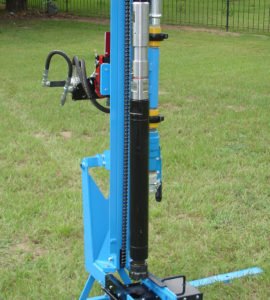Those who’ve used drilling equipment understand how much variation there is among the layers of sediment. Generally, the first few layers of soil are relatively easy to get through; but progress can slow dramatically once the drill hits a hard rock formation.
Overcoming this obstacle will demand a high quality down-the-hole hammer, along with appropriately sized, durable drill pipe and bits.
DTH Hammers for the Win

If you’re running into hard rock formations, it might be time to invest in heavier, more rugged drill rigs with accessories to power through dense material. A down-the-hole (DTH) hammer is a great example. When paired with any of Lone Star’s hydraulic drills, they reach up to 300-foot depths to power through limestone, sandstone and quartzite faster than standard mud rotary bits.
The DTH hammers Lone Star Drills offers operate with a wide range of drilling equipment without the need for specialized adapters. Our 3-inch-diameter hammer can be powered with air compressors with outputs as low as 185 cfm and 100 psi. This means you can use it with construction compressors that are readily found on the used equipment market or through rental dealers. To achieve faster drill speeds, use a more powerful air compressor.
The 3-inch model can be used with a 4-inch internal diameter casing set in the overburden to drill a 3-3/4-inch or 3-7/8-inch borehole in underlying rock. Alternatively, with the LS400 drill rig you can use the 5-inch hammer with 3-1/2-inch drill pipe to drive a 5-7/8-inch borehole through hard rock formations.
Stability in Any Terrain
Drilling effectiveness depends on factors such as anchoring setup, bit types and the drilling unit itself. For example, as you use more torque and power to drill down, the torque can rock the unit, which can require driving anchors into the ground to stabilize the trailer. Drilling through heavier soil could require a rugged rig, which may need additional anchoring for stability.
For heavier, trailer-mounted rigs, anchoring the drilling platform isn’t always necessary. But for smaller, lightweight drilling equipment, such as the LS200H, LS200H+, LS300H and LS300H+, anchoring stabilizes the platform (equipment trailer) and helps force drill bits through soil and rock.
The Lone Star Drills LS200H and LS300H series require 30-inch-long anchors for projects in clay, loamy and sandy soils. But if the drill site is on rocky terrain, you’ll have to find a different way to anchor the drills, such as adding water-filled tanks or barrels packed with rocks onto the unit. This anchoring force is crucial to pushing DTH hammers and heavy-duty drill bits through rocky material.
Choose Your Drilling Equipment Wisely
Choosing the right bit not only makes the drill more effective, but it also improves the lifespan of the bit and reduces the number of times you’ll need to buy replacements. For example, a drag bit will prematurely wear out and fail to penetrate rocky soils if used for that application. Instead, once the drag bit reaches hard rock, switch to a tricone bit or a DTH hammer to power through.
Selecting proper equipment for the task at hand is essential, and we’re ready to help you choose the ideal rig for your next job. Check out our full lineup of Lone Star Water Well Drills and contact us today.